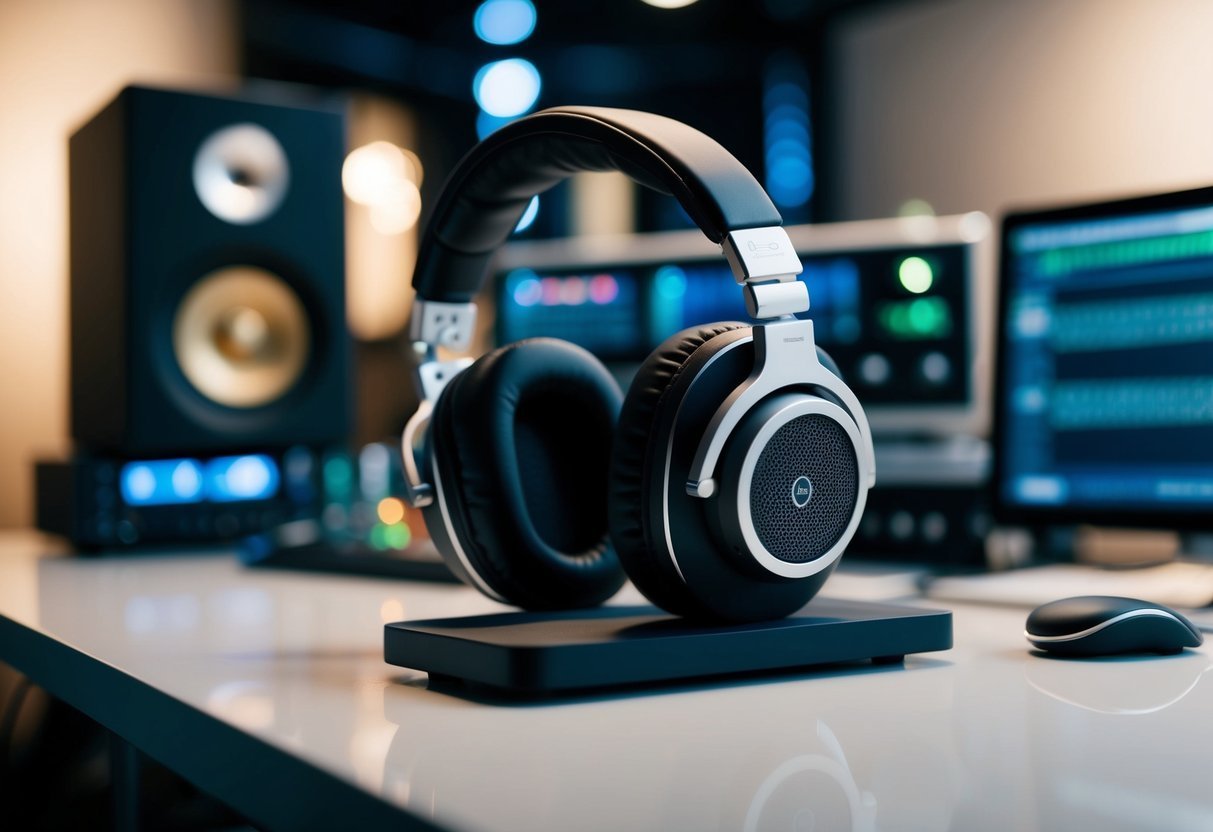Choosing the right headphones for studio monitoring can be a game-changer for your music production workflow.
Whether you’re mixing, mastering, or recording, a reliable pair of studio headphones ensures you’re hearing every detail with precision.
For the best results, you need headphones that offer accurate sound reproduction and comfort for those long sessions.
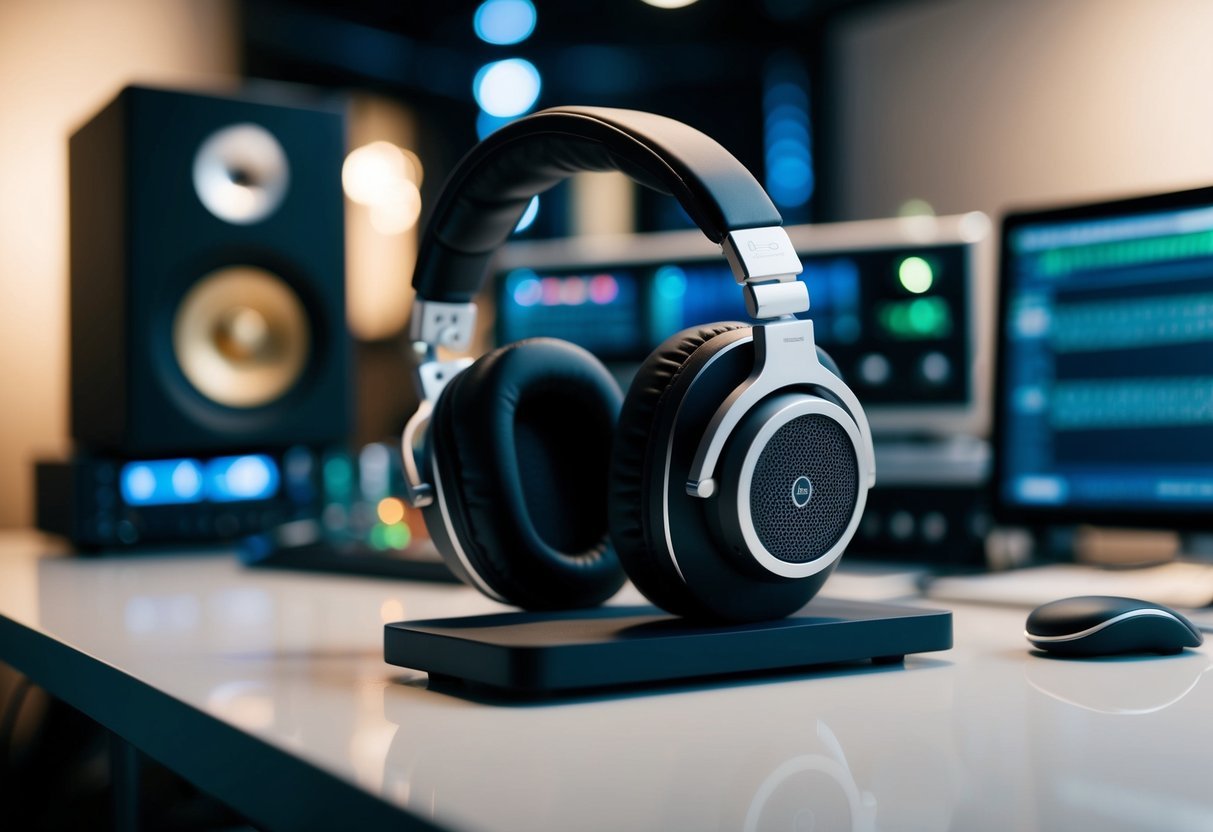
When you’re diving into audio work, open-back and closed-back headphones both have their place. Open-back options like the Sennheiser HD 650 provide a natural and spacious sound, making them ideal for mixing.
Meanwhile, closed-back headphones, such as the Audio-Technica ATH-M50x, are perfect for recording because they isolate sound, minimizing background noise interference.
Beyond just sound quality, consider factors like durability and comfort.
You’ll want something that can withstand regular use and feel comfortable on your head for hours.
Whether you go with versatile models like the Beyerdynamic DT 770 Studio or another popular choice, it’s about matching your needs with the right gear.
Understanding Studio Headphones
When choosing studio headphones, focus on key features and distinctions between designs.
Open-back and closed-back headphones provide different sound experiences that can impact your studio work.
Key Features of Studio Headphones
Studio headphones are specially crafted for precise audio monitoring.
You’ll find features like high impedance for improved sound quality.
This can enhance your listening experience by providing a cleaner, more detailed sound.
Durability is crucial.
Studio headphones are often built to withstand long sessions, so look for robust materials and repairability options.
The ability to handle high volumes without distortion is another important consideration.
Extra controls for fine-tuning can help with mixing and mastering.
Finally, soundstage is vital in studio headphones.
It refers to the perceived spatial location and distance of sound sources in audio playback.
A wider soundstage gives you a truer sense of depth.
Difference Between Open-Back and Closed-Back Headphones
Open-back headphones allow air and sound to pass through the ear cups.
This design offers a more natural and expansive soundstage, beneficial for mixing tracks where a sense of space is desired.
However, they are not great at isolating external noises.
Closed-back headphones, on the other hand, seal the ear cups to block external sounds.
You get more sound isolation, making them ideal when tracking or recording to avoid background noise interference.
The soundstage here is typically narrower, which may limit spatial representation but prevents sound leakage.
The Importance of Sound Quality and Frequency Response
Understanding sound quality and frequency response is crucial when choosing studio headphones.
A clear sound signature allows for precise audio monitoring, while a flat frequency response ensures accuracy across various frequencies.
Evaluating Sound Signature and Audio Performance
When picking studio headphones, getting familiar with the sound signature is quite important.
This represents how your headphones reproduce audio.
A neutral and natural sound signature is preferred for mixing, because it doesn’t overemphasize any frequency range.
Focus on aspects like bass response and treble clarity.
If the bass is too pronounced, it can muddy the mix, while sharp treble can cause listening fatigue.
Studio headphones should provide a transparent audio performance, allowing you to hear minute details in your recordings.
Select headphones that offer clear mids, steady highs, and controlled bass for a balanced output.
Frequency Response: The Backbone of Sound Quality
Frequency response refers to the range of sound frequencies that headphones can reproduce.
A standard frequency response range in headphones is usually between 20Hz and 20kHz.
However, achieving a flat frequency response is ideal for studio monitoring.
This essentially means that the headphones reproduce all audible frequencies equally. Flat frequency response enables you to listen to your audio uncolored, giving you a true representation of what’s recorded.
If a pair of headphones can maintain a consistent response across different frequencies, it helps in making accurate mix decisions.
Consider frequency response graphs when evaluating potential options, focusing on those with minimal peaks and dips.
Drivers: The Heart of Your Headphones
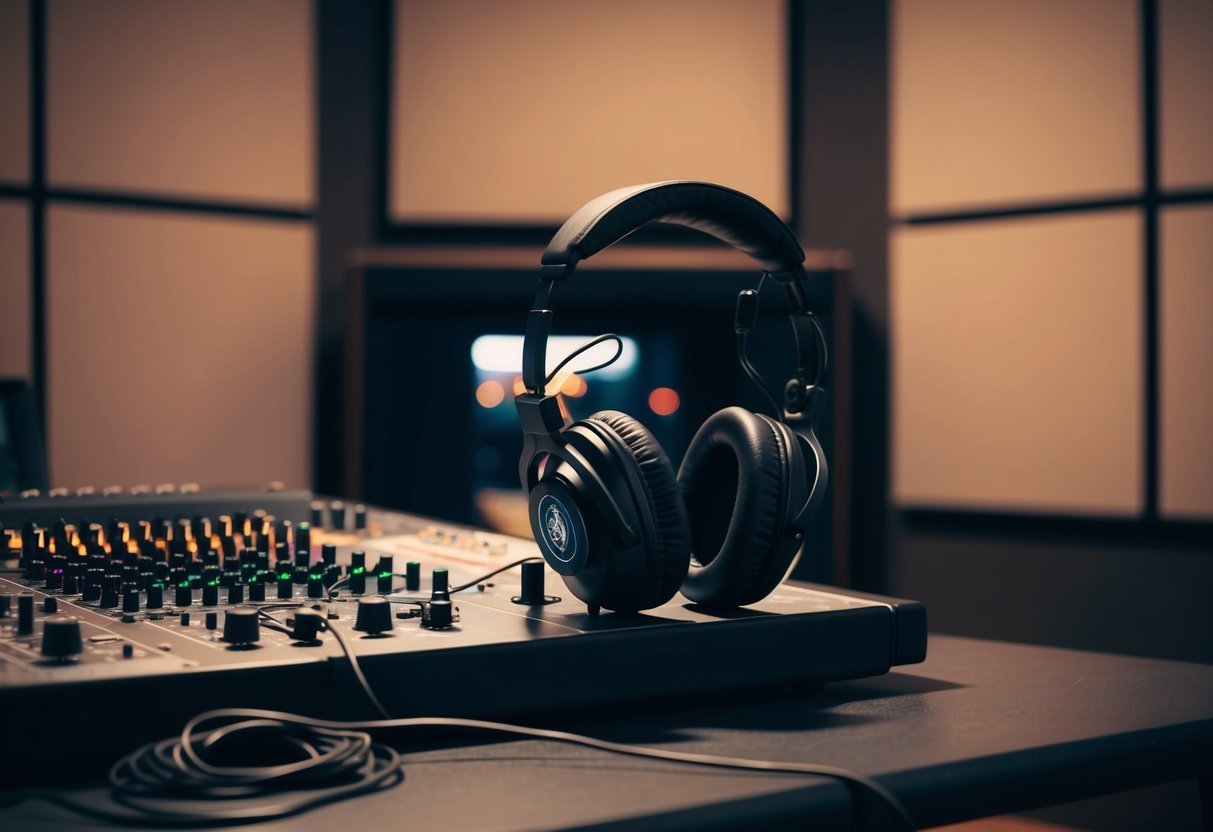
When it comes to studio headphones, drivers are crucial in defining the sound quality.
They convert electrical signals into sound and vary widely, impacting audio clarity and detail.
Choosing the right type depends on your specific needs and preferences.
Dynamic Vs. Planar Magnetic Vs. Electrostatic Drivers
There are three main types of drivers you might encounter: Dynamic, Planar Magnetic, and Electrostatic.
-
Dynamic drivers are the most common. They operate using a voice coil attached to a diaphragm, responding well to power variations. They are reliable for delivering punchy bass and are cost-effective.
-
Planar Magnetic drivers utilize a thin, flexible diaphragm sandwiched between magnetic fields. These provide greater accuracy, especially for mid and high frequencies, but they’re often bulkier and pricier.
-
Electrostatic drivers employ a charged diaphragm placed between two conductive plates. They offer exceptional clarity and responsiveness but require dedicated amplifiers and are usually the most expensive.
Each type has its strengths, making your choice dependent on what qualities you value most in sound production.
How Driver Size and Type Affect Sound
The size of the driver plays a significant role in sound reproduction.
Larger drivers, typically found in over-ear headphones, can produce more substantial bass due to their larger diaphragm.
For dynamic drivers, a larger size generally means deeper bass and higher volume capacity.
Planar Magnetic and Electrostatic drivers rely less on size for sound quality but need careful design to achieve their superior fidelity.
Planar drivers typically have a balanced sound across frequencies, while electrostatic drivers excel with detailed highs.
Choosing the right driver size and type allows you to tailor your listening experience to your specific audio production needs.
Whether you want deep bass, crisp highs, or balanced sound, there’s a driver setup for you.
Comfort and Wearability

Choosing the right studio headphones involves considering comfort and wearability.
Your choice greatly influences your ability to work comfortably over long periods, so we’ll look at different headphone styles and how their materials and design impact usability, especially during extended sessions.
Finding the Right Fit: Over-Ear, On-Ear, and In-Ear
When it comes to comfort, it’s essential to consider how different styles fit. Over-ear headphones wrap around your ears, providing a snug fit and excellent noise isolation.
They are often considered the most comfortable choice for long sessions.
On-ear headphones, meanwhile, rest on your ears and are generally more compact.
However, they can cause discomfort during extended use since they press against your ears.
In-ear monitors offer a lightweight alternative.
They fit directly into your ear canal, which can be comfortable for some but might feel intrusive to others.
They are quite portable and ideal if you’re moving around a lot.
Each type has its pros and cons, so you should consider what feels best for your personal needs and usage patterns.
Materials and Design for Extended Use
The materials and design of your headphones play a crucial role in comfort, especially for long hours in the studio.
Look for ear pads made of memory foam or high-quality leather, as these materials provide softness and breathability.
Durable design is also important to ensure your headphones can withstand the rigors of daily use.
Think about how much wear and tear they might encounter.
A flexible, adjustable headband adds comfort by allowing you to find the perfect fit without putting pressure on your head. Lightweight designs help reduce fatigue when wearing headphones for extended periods.
All these elements contribute to making your studio monitoring experience as comfortable as possible.
Selecting the Best Headphones for Mixing and Mastering
When picking headphones for mixing and mastering, detail and accuracy are everything.
You’ll want to focus on headphones that excel in delivering precise sound reproduction and consider the design that best suits your studio needs.
Studio Headphones That Shine for Critical Listening
When it comes to critical listening, balance and precision are key.
Look for headphones with a flat frequency response to ensure you hear every element of the mix accurately.
Beyerdynamic DT 1990 Pro and Audio-Technica ATH-M50x are popular choices due to their precise sound reproduction and dynamic range.
The Beyerdynamic DT 1990 Pro offers detailed sound and a durable build, whereas the Audio-Technica ATH-M50x provides reliable audio clarity but might not be as comfortable for long sessions.
Always consider comfort for those long studio hours.
Closed-Back vs. Open-Back for Studio Work
Deciding between closed-back and open-back headphones impacts the soundstage and comfort. Closed-back headphones, like the Beyerdynamic DT 770 Pro, are excellent for isolating sound, making them perfect for tracking and reducing environmental noise.
Open-back headphones, like the Philips SHP9600, offer a more natural sound stage, which is better suited for mixing and mastering sessions.
They can provide a sense of space and depth but require a quiet environment as they can leak sound.
Enhancing Audio with Headphone Amplifiers
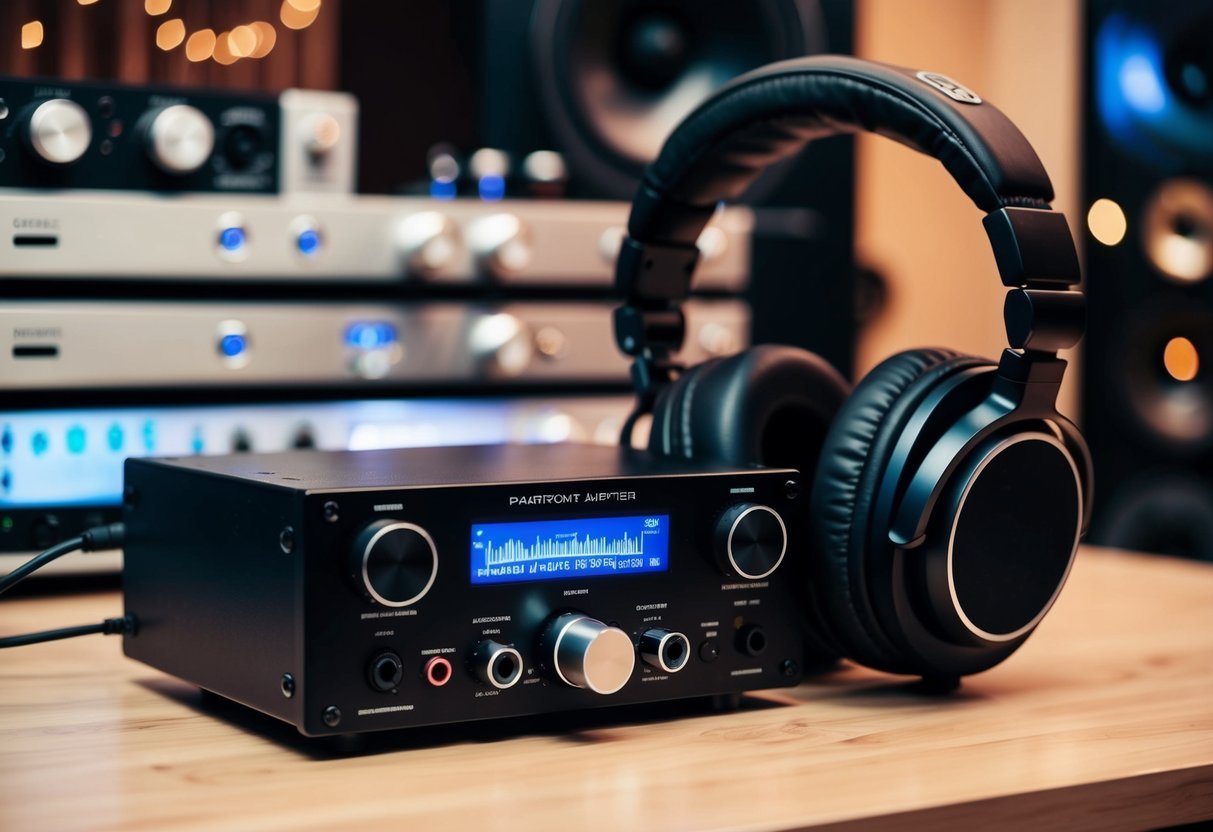
Headphone amplifiers are essential for getting the best audio quality, particularly when using high-impedance headphones.
They ensure that your headphones perform at their best by providing adequate power and maintaining sound clarity.
Do You Need a Headphone Amp?
If you’re after pristine sound quality and often work with studio headphones, a headphone amp can be a game-changer.
It boosts the audio signal, making it more capable of handling different frequencies with ease.
Improved dynamics, precise bass response, and a greater sense of depth are just some benefits you might notice.
Low-impedance headphones tend to work fine without an external amp, but when dealing with high-impedance models, extra power becomes essential.
Without it, you could experience weaker sound output and less dynamic range, which isn’t ideal for studio environments.
Matching Amps With Your Headphones’ Impedance
The impedance of your headphones determines how much power they need to operate efficiently.
High-impedance headphones, usually rated at over 100 ohms, demand more power to achieve optimal performance.
A suitable headphone amp can provide this required power, enhancing not just volume but also detail and clarity.
When matching amps, look for those designed for your specific impedance range.
Amps with higher output power will generally work better for high-impedance headphones, removing any bottleneck in audio quality.
By making the right pairing, you ensure your headphones deliver the accurate sound you need.
Durability and Longevity of Studio Headphones
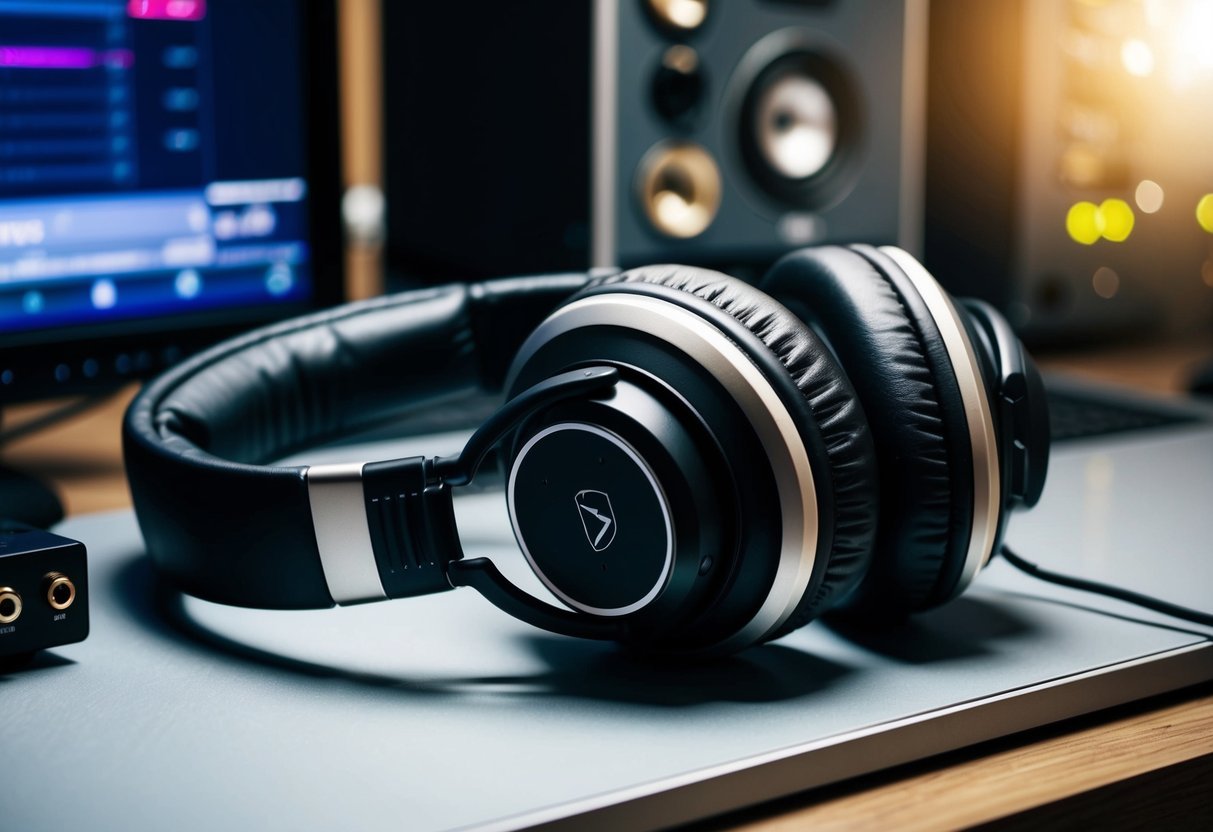
Choosing studio headphones involves a focus on durability and longevity.
How they’re built and how you maintain them can make a big difference in their lifespan.
Building to Last: Materials and Construction
When you’re picking headphones, keep an eye out for durable designs.
Strong and long-lasting materials like aluminum, high-grade plastic, and stainless steel will contribute to the overall durability.
Headband and ear cup materials should be robust yet comfortable.
A solid construction often includes reinforced joints and solid hinges, as these parts are prone to break under stress.
Look for headphones that boast a sturdy build and check user reviews for insights into how well they handle regular use.
Maintaining Your Headphones for Long-Term Use
Proper maintenance is key to extending the life of your studio headphones.
Start by keeping them clean.
Use a slightly damp cloth to wipe down headbands and ear cushions to prevent wear caused by sweat and grime.
Storing them in a protective case when not in use can minimize accidental falls or scratches.
Be mindful of how you wrap or store cables, avoiding sharp bends or heavy pressure.
Regularly check for any wear and tear to catch issues early.
Critical Considerations for Connectivity
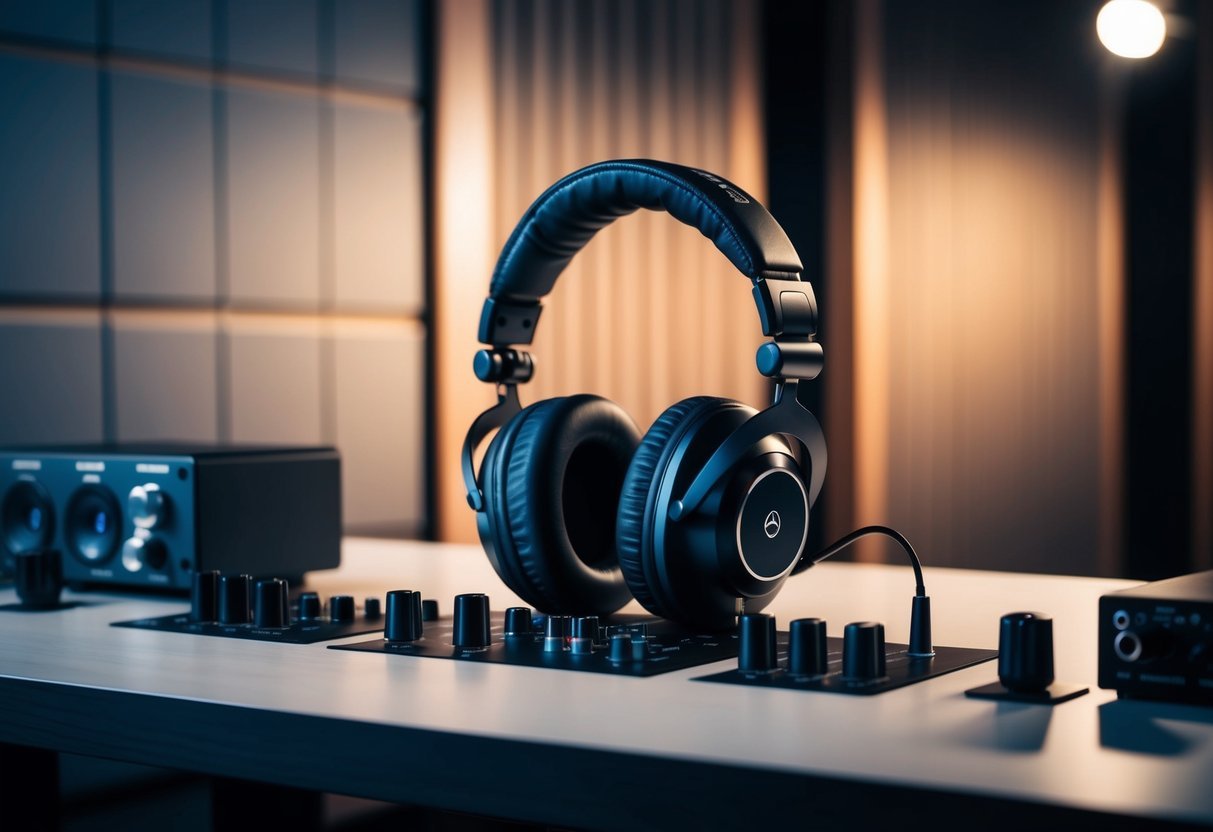
When choosing studio headphones, connectivity options can heavily influence your workflow and sound quality.
Whether you go for wired or wireless, each choice brings its own unique benefits and considerations, including cable quality and length impacting your experience.
Wired vs. Wireless: What’s Best for Studio Headphones?
In a studio setting, wired headphones often take the lead.
They offer consistent sound quality without the risk of signal interference, making them popular among producers who need reliability.
Brands like Audio-Technica and Beyerdynamic’s wired models are known for their exceptional performance.
If mobility is a key concern, you might consider wireless options; however, they can introduce latency issues that disrupt real-time syncing.
Wireless headphones are more common in casual listening settings but can be considered for studios with the latest low-latency technology.
Remember, sound quality may suffer in cheaper models.
If you prioritize sound consistency and accurate monitoring, sticking with wired options is generally recommended for most studio work.
Understanding the Impact of Cable Quality and Length
Cable quality and length are not just minor details—they play a significant role in your headphone’s performance.
A high-quality cable ensures clear sound transmission without interference, which is crucial for precise audio monitoring.
Investing in durable materials can save you from frequent replacements and protect against tangling.
Cable length also matters.
Too long, and you risk signal degradation; too short, and your movement around the studio is restricted.
A typical sweet spot ranges from 6 to 10 feet, providing enough room to navigate spaces without compromising on sound quality.
Choosing the right combination of cable length and quality can enhance your studio experience, enabling seamless integration into your audio setup, especially with well-regarded models from brands like Audio-Technica or Beyerdynamic.
Budgeting for Studio Headphones
When you’re budgeting for studio headphones, it can be tricky to balance quality and cost.
It’s essential to find headphones that offer excellent sound without breaking the bank.
Here, you will find insights on how to secure the most value for your budget and identify top-quality budget studio headphones available today.
Finding Value: High-Quality Headphones Within Your Price Range
When shopping for studio headphones on a budget, prioritize core features like sound clarity, comfort, and durability.
Sound clarity ensures accurate mixing and monitoring. Comfort allows for extended use without fatigue, and durability ensures a longer lifespan.
Consider brands known for delivering quality at a lower cost.
Look for sales, bundle deals, or secondhand options if needed. Balance is key.
Don’t compromise on sound quality for cost.
Instead, aim for headphones that provide both decent audio performance and comfort within your set price range.
The Best Budget Studio Headphones on the Market
Some headphones stand out for their excellent performance-to-price ratio.
The Audio-Technica ATH-M50x consistently appears in discussions as a reliable choice for budget studio headphones, praised for their sound accuracy and solid build.
Sennheiser HD 206 offers another affordable option, noted for their clear sound and comfortable fit, ideal for daily studio use.
Additionally, the Superlux HD 681 provides a compelling blend of price and performance, making them a popular choice among beginners.
By focusing on models like these, you can find dependable options that meet your studio needs without going over budget.
Notable Studio Headphone Models and Brands

Finding the right studio headphones can be crucial for any audio project.
Some models like the Beyerdynamic DT 770 PRO are ideal for tracking due to their closed-back design and exceptional comfort.
Others, such as the Audio-Technica ATH-M50x, are celebrated for offering accurate sound reproduction at a reasonable price.
An Overview of Popular Studio Headphones
The Audio-Technica ATH-M50x is widely respected for its balanced sound and durability.
These headphones provide excellent sound isolation, a feature that’s valued in loud environments.
If you’re looking for something under $100 with great performance, the Audio-Technica ATH-M20x is a strong contender.
For open-back alternatives, the Beyerdynamic DT 990 PRO is highly popular for mixing and mastering, allowing for a spacious and airy soundstage.
The Sennheiser HD 800 S is another excellent choice in the open-back category, offering a remarkable level of detail and precision, appealing to audiophiles and professionals alike.
If you’re on a budget, the Sennheiser HD 280 PRO offers a solid performance for less, commonly utilized for monitoring in studios due to its reliability and longevity.
What Professionals Use: Headphones in the Industry
In professional studios, the Sony MDR-7506 is almost a legend for broadcasting and film production needs, thanks to its flat response and portability.
The Beyerdynamic DT 900 PRO X, having been introduced in recent years, is gaining traction for its versatile monitoring capabilities.
The Audeze MM-100 attracts professionals interested in planar magnetic drivers, known for producing less distortion and offering greater clarity, which is invaluable during critical listening sessions.
Frequently Asked Questions
When you’re diving into studio monitoring headphones, it’s important to focus on sound quality and functionality.
Check out features like sound accuracy, comfort, and build quality for the best results.
What makes a pair of headphones suitable for studio monitoring?
Studio monitor headphones aim for accurate sound reproduction without coloring the audio.
They help you hear the music exactly as it is.
Look for headphones with a flat frequency response and excellent clarity across the audio spectrum.
Are there any disadvantages to using wireless headphones for studio work?
Wireless headphones can introduce latency, which is the delay between the sound being played and heard.
This lag is not ideal for recording or mixing where timing is crucial.
Also, wireless connections aren’t always as stable compared to wired solutions.
Which features should I look for in headphones when mixing and mastering tracks?
When mixing and mastering, prioritize sound accuracy and comfort.
Open-back designs offer a natural soundstage, but closed-back headphones give more isolation if you’re in a noisy environment.
Durability and adjustable features for personalized fit are also helpful.
How do professional studio engineers choose their headphones?
Studio engineers typically test headphones by listening to tracks they are familiar with.
They assess comfort over long sessions, evaluate the sound quality, and consider the build materials.
Reviews from peers also play a role in their decision-making process.
Can regular headphones be used for recording vocals or do you need something specific?
While regular headphones can work, studio monitor headphones are better for recording vocals due to their accuracy and isolation.
Regular headphones may include sound enhancements, which can color the sound, making it less reliable for precise studio tasks.
What are some top recommended headphones for studio professionals on a budget?
Looking for budget-friendly options? The Audio-Technica ATH-M50x and the Beyerdynamic DT 990 Pro offer good sound quality and comfort without breaking the bank.
Many professionals praise them for their performance and reliable construction.

